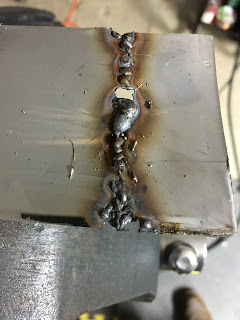I thought I'd posted this previously, but apparently was among a batch of photos that expired as a result of drag and drop metadata. Here they are again.
 |
| A rectangular piece was cut and rolled, then a cut line was marked on the inside edge. |
 |
| Some tac welds in the .025" SS. |
 |
| It was easy to blow through using .030 wire. I should have had .025". |
 |
| One hole was drilled for the butterfly shaft and then then where to drill the opposite hole was found with a folded piece of paper. |
 |
| Drilling stainless is a pain. The drill bits love to grab when they finally break through. Backing up with wood helps. |
 |
| I cut a tube at an angle and traced around it to make a pattern for the butterfly. |
 |
| The butterfly template. |
 |
| The installed valve. Riveted baffling material makes the flexible gasket on the butterfly. A drilled brass rod secures the butterfly. The valve fits snuggly. |
 |
| Engine side view. It's slightly egg shaped but a hose clamp on the scat tube forces it round. |















